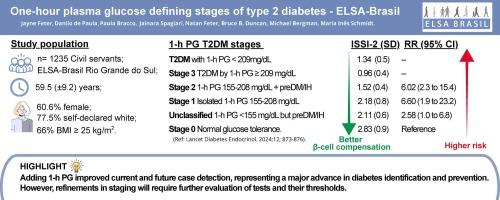一小时血浆血糖对2型糖尿病分期的定义——elsa -巴西研究。
IF 7.4
3区 医学
Q1 ENDOCRINOLOGY & METABOLISM
引用次数: 0
摘要
目的:通过检查口服β细胞代偿的下降和糖尿病风险的增加来评估先前提出的2型糖尿病分期模式。方法:我们分析了来自elsa巴西中心的1,235名参与者(43-85 岁)。我们按照先前提出的方法定义分期:第1阶段,分离1-h PG≥155 mg/dL;2期,同时患有美国糖尿病协会(ADA)定义的糖尿病前期/中度高血糖症(preDM/IH);第三阶段,糖尿病。我们根据世界卫生组织(WHO)/国际专家委员会(IEC)的标准对IH进行了进一步的评估。我们用胰岛素分泌敏感性指数-2 (isi -2)估计β细胞代偿。结果:isi -2下降(p )结论:分期捕获进行性恶化为2型糖尿病。添加1-h PG改善了当前和未来的病例检测,这代表了糖尿病预防的重大进展。然而,分级的改进将需要进一步评估测试及其阈值。本文章由计算机程序翻译,如有差异,请以英文原文为准。

One-hour plasma glucose defining stages of type 2 diabetes − The ELSA-Brasil study
Aims
To evaluate a previously proposed type 2 diabetes staging schema by examining the decline in oral beta-cell compensation and the increase in diabetes risk.
Methods
We analyzed 1,235 participants (43–85 years) from one ELSA-Brasil center. We defined stages as previously proposed: stage 1, isolated 1-h PG ≥155 mg/dL; stage 2, also having prediabetes/intermediate hyperglycemia (preDM/IH) defined by the American Diabetes Association (ADA); and stage 3, diabetes. We made additional evaluations defining IH based on the World Health Organization (WHO)/International Expert Committee (IEC) criteria. We estimated beta-cell compensation with the insulin secretion-sensitivity index-2 (ISSI-2).
Results
ISSI-2 declined (p < 0.001) across stages. After 5.29 (0.44) years (n = 850), the adjusted diabetes incidence increased from stage 0 (normoglycemia) to stage 1 (RR = 2.64;1.12,6.22) and stage 2 (RR = 5.94;2.83,12.44), considering WHO/IEC criteria. With the ADA criteria, RRs were larger but not progressive. Adding 1-h PG testing doubled the detection of unknown diabetes. A strategy combining FPG with 1-h PG performed just as well as using all four tests.
Conclusions
Staging captured progressive deterioration to type 2 diabetes. Adding 1-h PG improved current and future case detection, which represents a major advance in diabetes prevention. However, refinements in staging will require further evaluation of tests and their thresholds.
求助全文
通过发布文献求助,成功后即可免费获取论文全文。
去求助
来源期刊

Diabetes research and clinical practice
医学-内分泌学与代谢
CiteScore
10.30
自引率
3.90%
发文量
862
审稿时长
32 days
期刊介绍:
Diabetes Research and Clinical Practice is an international journal for health-care providers and clinically oriented researchers that publishes high-quality original research articles and expert reviews in diabetes and related areas. The role of the journal is to provide a venue for dissemination of knowledge and discussion of topics related to diabetes clinical research and patient care. Topics of focus include translational science, genetics, immunology, nutrition, psychosocial research, epidemiology, prevention, socio-economic research, complications, new treatments, technologies and therapy.
 求助内容:
求助内容: 应助结果提醒方式:
应助结果提醒方式:


